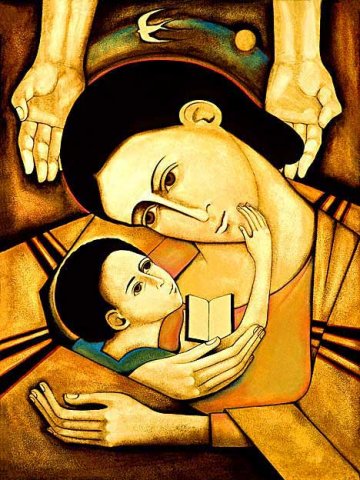Bearing Witness – by Anne Weirich
 Read Abigail Henrich’s Essay, “Bearing the Word and Finding One’s Authority”
Read Abigail Henrich’s Essay, “Bearing the Word and Finding One’s Authority”
Read Jerusha Neal’s Essay, “Laboring to Speak From the Shadows”
Introductory note: In medieval art, as in this contemporary painting, Mary has been regularly depicted with a book in her hand – underscoring her role as Mother of the Word. In these reflections on preaching, Anne Weirich, Jerusha Neal and Abigail Henrich take this designation seriously, reinterpreting Mary’s story to refer, not simply to the experience of childbirth and mothering, but also to the very real, word-driven labor of spoken proclamation. Using Michael O’Brien’s luminous depiction as a common point of reference, they ask: How might Mary’s experience in bearing the Word to the world illuminate the preacher’s act of bearing witness?
In a class at seminary, I was studying the Hebrew of an Old Testament text in a small group. The leader was a local rabbi. He was a fairly young man who had been teaching a morning Torah class at his temple for fourteen years. He explain that he had started “at the beginning” in Genesis and had been doing a line by line discussion each week for all those years. And he wasn’t nearly through Exodus. For him, each jot and tittle was important – an opportunity for discussion.
He went on to speak about his understanding of a verse we were looking at that day. After his exegesis, I raised my hand and asked one of those, “Well if that’s true, then isn’t so and so true as well?” kind of questions. His face lit up, his eyes crinkled behind his glasses, a smile broke out from within his dark beard and he said, “Yes, yes – you my friend, you have found the blessing in the text.”
I believe that moment formed me for preaching. Since then, my labor with scripture has always taken the form of this search for the blessing in the text. If a blessing doesn’t seem to be on the surface, it means that I just haven’t found it yet.
Most often, the blessing comes to me through a kind of excavation. I love scraping away layers of meaning that are hidden in the history and composition of the actual words themselves. Finding the context in history and geography of the story or teaching opens new trails to follow that might lead to God’s grace. Always and ever, there is a search for the quickening of understanding, the birth of something new and a thread of letters and words that binds the meaning together so that it can be preached in a way that is winsome and engaging and useful.
As I excavate Scripture, I sit on my living room couch and eventually, I surround myself with books. In my mind, there is a map of my library of resources – fiction, poetry, commentaries, articles in files, and on the Internet, YouTube videos, images, dictionaries and curriculum. If I get stuck, I’ll wander past the book shelves,that in my current home are spread out in four different rooms, to see if something leaps off the shelf at me. The pages shift and paragraphs come to mind. The words pick at my life and the lives of those I serve and settle into a Sentence studded with borrowed and experienced authority and witness.
I know the sermon is done in my mind and heart when I have been changed in a way that I can put into words – that I can name. Hopefully, then, those who hear will be changed, too.
And when the words are ready to be written, it is a joy to see them move from my mind through my finger tips onto the screen. Printing is also a ritual – heavy gauge paper – with a good feel and heft – makes the sermon feel complete. When words are on the page, connected by a blessing in the text feel satisfying in my hand, I know the labor is done.
I come to preaching as a single woman, never married, without children. I have been a daughter, but never a mother. I have loved children, but not my own. I have been a lover, but not as a wife. Someone once told me that since I hadn’t been a parent, I could never understand what being loved by God felt like. The implication was that, therefore, my preaching and care giving couldn’t be as effective. Another person told me, in response to this, with a somewhat rueful smile, that maybe I understood God’s love better because it was so easy for parents to mistake God’s love for the kind of love a parent has for their child. The truth may lie somewhere in between, I suppose.
But the effect has been that the image of Mary, mother of the Word, and images of pregnancy and labor as a metaphor for preaching are somewhat lost on me. The blessing in the texts about her as the mother of the Word come home to me much more in the story of Mary’s meeting with her cousin Elizabeth.
In those days Mary set out and went with haste to a Judean town in the hill country, where she entered the house of Zechariah and greeted Elizabeth. When Elizabeth heard Mary’s greeting, the child leapt in her womb. And Elizabeth was filled with the Holy Spirit and exclaimed with a loud cry, ‘Blessed are you among women, and blessed is the fruit of your womb. And why has this happened to me, that the mother of my Lord comes to me? For as soon as I heard the sound of your greeting, the child in my womb leapt for joy. And blessed is she who believed that there would be a fulfillment of what was spoken to her by the Lord.’ Luke 1:39-45
As Jerusha, Abby and I looked for a painting to reflect upon for these meditations on preaching, I found “Mother and Child Reading the Word” by Michael D. O’Brien to be the most complete. The reason I was drawn to his beautiful image was because, in it, I saw room for Elizabeth.
The hands surrounding the mother and child and the book could be Elizabeth’s hands. They surround this holy family of mother, son and Spirit, like the hands of a good and loving cousin.
After all, at her advanced age, in her more exalted position as the wife of a temple priest, her pregnancy was even more esteemed, perhaps even more of a miracle.[1]
She could have burst forth in protest or disbelief. But she looked beyond the simple child who ran to her from Nazareth. Her mind sifted through the stories of her faith, the voices of prophets and kings. And filled with the joy that moved inside her she had a different word for Mary – a word that changed things.
She burst forth with a spoken blessing.
She burst forth with a name – “my Lord.”
She burst forth making all things new.
In the painting, her hands seem to extend in embrace. Through her embrace, there is room at this nativity for all. As her child leaps within her body, in recognition of the Blessing that is coming into the world, so may we all be quickened in the knowledge and love of the Lord.
The Word. The Lord. I believe he can come to us in the sound of our greeting – the ways of preaching. Blessed are you, too, among women, Elizabeth, for your name means “God has sworn.” A blessed promise, indeed.
Read Abigail Henrich’s Essay, “Bearing the Word and Finding One’s Authority”
Read Jerusha Neal’s Essay, “Laboring to Speak From the Shadows”
[1] Renita Weems, Just a Sister Away. Innisfree Press, Inc.: Philadelphia, 1988, p. 121.

